Unique Private Ancient Message Discovered Carved On Large T-Shaped Maya Jade Pendant Could Change What We Know About The Maya
MessageToEagle.com – It’s a quite extraordinary discovery. The second largest jade has been found in Belize. It’s a large Maya pendant that was won on a king’s chest is carved with a unique inscription.
The T-shaped jade pendant has a private ancient message seen mostly by the king who wore it. According to researchers, it’s a short and intriguing ancient text that could change what we know about the Maya.
The artifact was found in Nim Li Punit, a small site in the Toledo District of Belize by Archaeologist Geoffrey Braswell from the University of California.
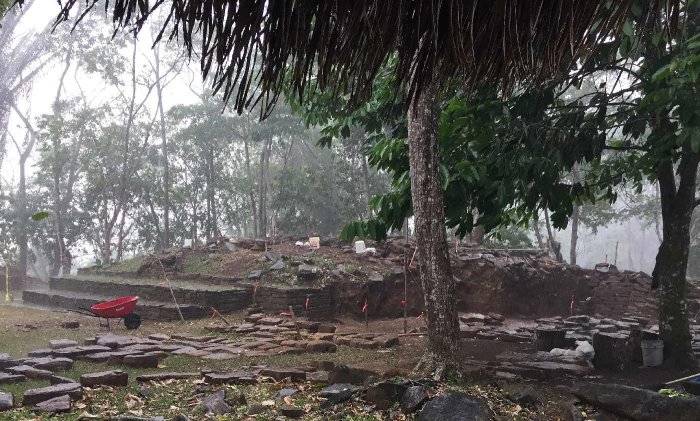
“It was like finding the Hope Diamond in Peoria instead of New York,” said Braswell, who led the dig that uncovered a large piece of carved jade once belonging to an ancient Maya king. “We would expect something like it in one of the big cities of the Maya world. Instead, here it was, far from the center,” he said.
The Maya Jade Pendant Tells An Important Story
The pendant measures 7.4 inches wide, 4.1 inches high and just 0.3 inches thick. Sawing it into this thin, flat form with string, fat and jade dust would have been a technical feat.
However, what makes the pendant even more remarkable, is that it’s the only one known to be inscribed with a historical text. Carved into the pendant’s back are 30 hieroglyphs about its first owner.
“It literally speaks to us. The story it tells is a short but important one,” Braswell said and pointed out that he also believes the artifact can change what we what we know about the Maya.
The pendant is not only in the shape of a T, but its front is carved with a T also. This is the Mayan glyph “ik’,” which stands for “wind and breath.” It was buried, Braswell said, in a curious, T-shaped platform. And one of the pots discovered with it, a vessel with a beaked face, probably depicts a Maya god of wind. According to ancient Maya beliefs, Kukulkan was the god of wind, sky and the Sun. He was a supreme leader of the gods and depicted, just like Quetzalcoatl as a combination of a snake rattlesnake from the quetzal bird.
Read more: https://www.messagetoeagle.com/kukulkan-feathered-serpent-mighty-mayan-snake-god/#ixzz4Zj5kxliV
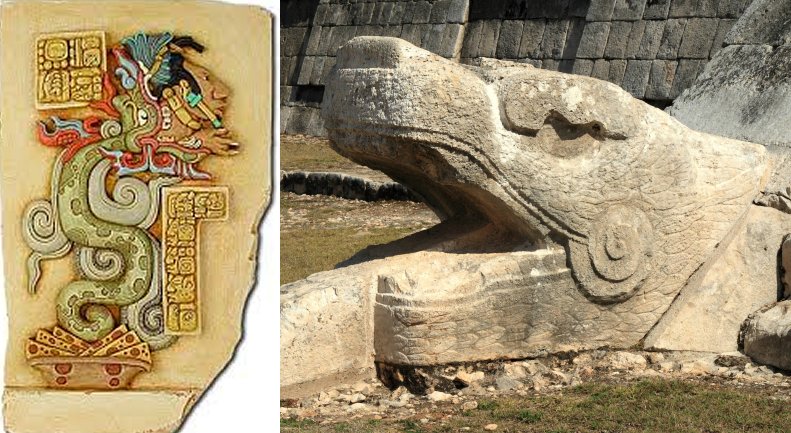
The wind played an important part in the lives of the ancient Maya. It brought annual monsoon rains that made the crops grow. Maya kings—as divine rulers responsible for the weather—performed rituals according to their sacred calendar, burning and scattering incense to bring on the wind and life-giving rains.
According to the inscription on its back, Braswell said, the pendant was first used in A.D. 672 in just such a ritual.
Two relief sculptures on large rock slabs at Nim Li Punit also corroborate that use. In both sculptures, a king is shown wearing the T-shaped pendant while scattering incense, in A.D. 721 and 731, some 50 and 60 years after the pendant was first worn.
Why Was The Precious Jade Pendant Not Buried With Its Owner?
By the year A.D. 800, the pendant was buried, not with its human owner, it seems, but just with other objects. Why? The pendant wasn’t a bauble, Braswell said, “it had immense power and magic.” Could it have been buried as a dedication to the wind god? That’s Braswell’s educated hunch.
See also:
Kukulkan: Feathered Serpent And Mighty Mayan Snake God
New Clues To Maya Collapse Uncovered
Blue Hole In Belize Could Explain The Collapse Of The Mayan Civilization
Maya kingdoms were collapsing throughout Belize and Guatemala around A.D. 800, Braswell said. Population levels plummeted. Within a generation of the construction of the tomb, Nim Li Punit itself was abandoned.
“A recent theory is that climate change caused droughts that led to the widespread failure of agriculture and the collapse of Maya civilization,” Braswell said.
“The dedication of this tomb at that time of crisis to the wind god who brings the annual rains lends support to this theory, and should remind us all about the danger of climate change.”
What Does The Ancient Private Message On The Jade Pendant Tell Us?
The inscription on the back of the pendant is perhaps the most intriguing thing about it, Braswell said.
The text is still being analyzed by Braswell’s coauthor on the Ancient Mesoamerica paper, Christian Prager of the University of Bonn. We should not forget that the Mayan script itself is not yet fully deciphered or agreed upon.
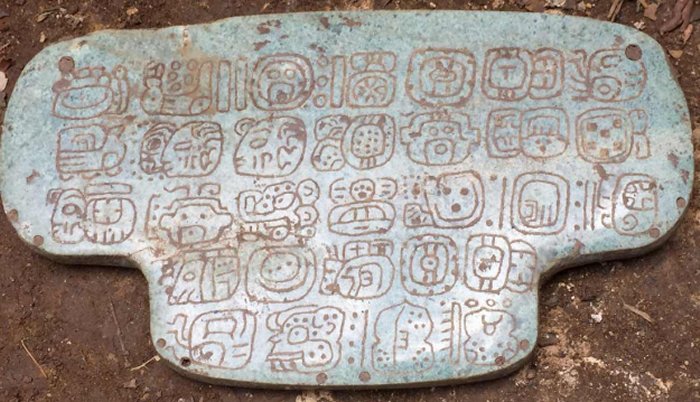
But Prager and Braswell’s interpretation of the text so far is this: The jewel was made for the king Janaab’ Ohl K’inich.
In addition to noting the pendant’s first use in A.D. 672 for an incense-scattering ceremony, the hieroglyphs describe the king’s parentage. His mother, the text implies, was from Cahal Pech, a distant site in western Belize. The king’s father died before aged 20 and may have come from somewhere in Guatemala.
It also describes the accession rites of the king in A.D. 647, Braswell said, and ends with a passage that possibly links the king to the powerful and immense Maya city of Caracol, located in modern-day Belize.
“It tells a political story far from Nim Li Punit,” Braswell said. He notes that Cahal Pech, the mother’s birthplace, for example, is 60 miles away. That’s a five-hour bus ride today, and back then would have been many days’ walk—through rainforest and across mountains. How did the pendant come to this outpost?
See also:
Mystery Of The Maya Blue Pigment And Its Unusual Chemical Composition
Ceibal Is The Oldest Known Ceremonial Site Of The Maya Civilization
Xochicalco: Stunning Ruins Of Sacred City Linked To Maya and Aztecs Civilizations
More Fascinating Ancient Civilizations And Places
While it’s possible it had been stolen from an important place and whisked away to the provinces, Braswell doesn’t think so. He believes the pendant is telling us about the arrival of royalty at Nim Li Punit, the founding of a new dynasty. The writing on the pendant is not particularly old by Maya standards, but it’s the oldest found at Nim Li Punit so far, Braswell said. It’s also only after the pendant’s arrival that other hieroglyphs and images of royalty begin to show up on the site’s stelae, or sculptured stone slabs.
It could be that king Janaab’ Ohl K’inich himself moved to Nim Li Punit, Braswell said. Or it could be that a great Maya state was trying to ally with the provinces, expand its power or curry favor by presenting a local king with the jewel. Either way, Braswell believes, the writing on the pendant indicates ties that had been previously unknown.
“We didn’t think we’d find royal, political connections to the north and the west of Nim Li Punit,” said Braswell, who has been excavating in Belize since 2001 and at Nim Li Punit since 2010. “We thought if there were any at all that they’d be to the south and east.”
Even if you ignore the writing and its apparent royal provenance, the jade stone itself is from the mountains of Guatemala, southwest of Belize. There are few earlier indications of trade in that direction either, Braswell said.
We may never know exactly why the pendant came to Nim Li Punit or why it was buried as it was, but Braswell’s project to understand the site continues. He plans to return in the spring of 2017. This time, he also wants to see if he might discover a tie to the Caribbean Sea.
MessageToEagle.com
Expand for referencesRelated Posts
-
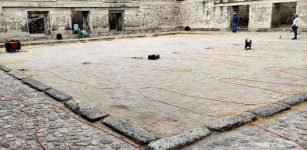 Has The Mysterious Ancient Underground Labyrinth Of Mitla Finally Been Found?
No Comments | Aug 15, 2023
Has The Mysterious Ancient Underground Labyrinth Of Mitla Finally Been Found?
No Comments | Aug 15, 2023 -
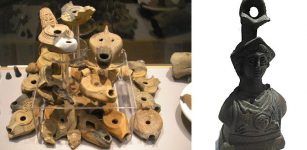 Yenikapı Excavations Reveal 8,500-Year-Old Artifacts
No Comments | Jan 11, 2016
Yenikapı Excavations Reveal 8,500-Year-Old Artifacts
No Comments | Jan 11, 2016 -
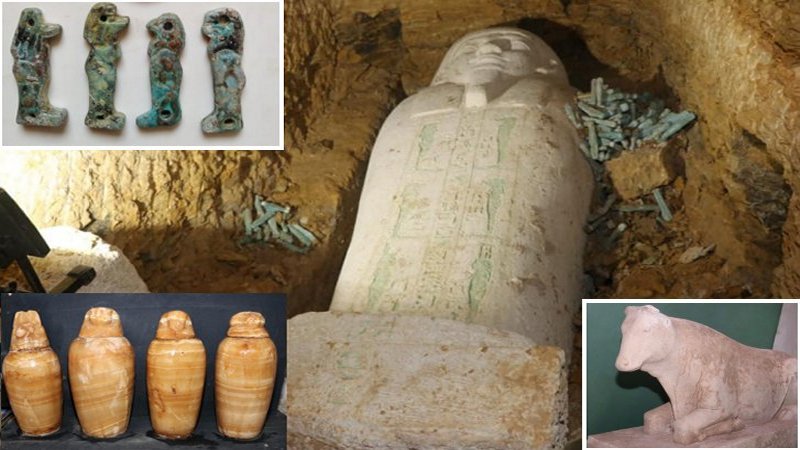 Hundreds Of Marvelous Ancient Egyptian Treasures Found Inside Tombs In Minya
No Comments | Oct 27, 2020
Hundreds Of Marvelous Ancient Egyptian Treasures Found Inside Tombs In Minya
No Comments | Oct 27, 2020 -
 Submerged 10,000 Years Old Monolith Discovered In The Sicilian Channel Near Italy
No Comments | Aug 6, 2015
Submerged 10,000 Years Old Monolith Discovered In The Sicilian Channel Near Italy
No Comments | Aug 6, 2015 -
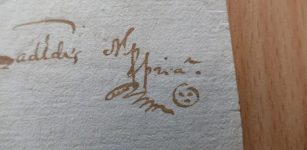 World’s Oldest Emoji Discovered In Slovakia – It Was Drawn By A Lawyer 382 Years Ago
No Comments | Feb 10, 2017
World’s Oldest Emoji Discovered In Slovakia – It Was Drawn By A Lawyer 382 Years Ago
No Comments | Feb 10, 2017 -
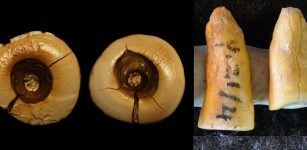 Ancient Dentistry – 13,000-Year-Old Tooth Filling Discovered In Italy
No Comments | Apr 11, 2017
Ancient Dentistry – 13,000-Year-Old Tooth Filling Discovered In Italy
No Comments | Apr 11, 2017 -
 The Americas Were Not Populated Via The Ice-Free Corridor More Than 15,600 Years Ago – New Study Of Boulders Reveals
No Comments | Mar 23, 2022
The Americas Were Not Populated Via The Ice-Free Corridor More Than 15,600 Years Ago – New Study Of Boulders Reveals
No Comments | Mar 23, 2022 -
 Face Of Pictish Man Brutally Murdered 1,400 Years Ago – Reconstructed
No Comments | Feb 18, 2017
Face Of Pictish Man Brutally Murdered 1,400 Years Ago – Reconstructed
No Comments | Feb 18, 2017 -
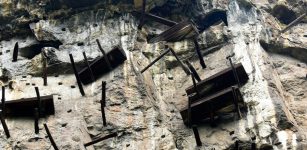 Mysterious Cliff Burial: 131 Ancient Hanging Coffins Found In Hubei Province, China
No Comments | Dec 15, 2015
Mysterious Cliff Burial: 131 Ancient Hanging Coffins Found In Hubei Province, China
No Comments | Dec 15, 2015 -
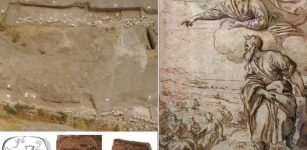 Biblical City In Zanoah Offers Archaeological Evidence Of Moses’ Journey To The Promised Land
No Comments | Jul 22, 2024
Biblical City In Zanoah Offers Archaeological Evidence Of Moses’ Journey To The Promised Land
No Comments | Jul 22, 2024
